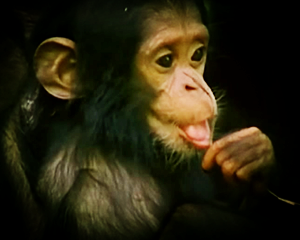It was 1987 in Tanzania and the chimpanzee Chausiku was doing something very peculiar.
那是1987年的坦桑尼亚,黑猩猩乔西库正在做一些非常奇特的事情。
Primatologist Michael Huffman noticed Chausiku was chewing the bark of shrub Vernonia amygdalina, commonly known as bitter leaf -- a plant that was not a normal part of her diet.
灵长类动物学家迈克尔·霍夫曼注意到乔西库正在咀嚼灌木斑鸠菊的树皮,这种植物通常被称为苦叶,并且不是乔西库日常饮食的一部分。
Since bitter leaf is used across Africa by humans as a remedy against malaria fever, stomachache, and intestinal parasites, Huffman speculated that Chausiku might be self-medicating, as she had been acting lethargic and with little appetite over a period of days.
由于非洲各地的人类都用苦叶来治疗疟疾发烧、胃痛和肠道寄生虫,霍夫曼推测乔西库可能是在自我治疗,因为她在几天内一直表现得昏昏欲睡、食欲不振。
His hypothesis was met with both excitement and disbelief.
他的假设引起了人们的兴奋和怀疑。
Indeed, just 22 hours later, Chausiku was back to her healthy, energetic self. Later research suggested Chausiku might have had a nodular worm infection in her gut.
事实上,仅仅22小时后,乔西库就恢复了健康、充满活力的状态。后来的研究表明,乔西库的肠道可能感染了结节性蠕虫。
By analyzing the improvement in her feces, urine, and behavior, Huffman made the case for this being the scientifically documented example of self-medication in animals.
通过分析她的粪便、尿液和行为的改善,霍夫曼证明了这是有科学记录的动物自我药疗的例子。
Huffman, now a professor at the Wildlife Research Center of Kyoto University, admits that figuring out whether an animal is medicating is somewhat like an educated guess.
霍夫曼现在是京都大学野生动物研究中心教授,他承认,弄清楚动物是否具有药物作用有点像是一种有根据的猜测。
"We can only describe what we see and then measure the outcomes of those actions," he says. "But since we cannot talk to animals, we do not know what they are thinking when they self-medicate."
“我们只能描述我们所看到的,然后衡量这些行动的结果,”他说。“但由于我们无法与动物交谈,我们不知道它们自我治疗时在想什么。”
Nevertheless, he believes there are both innate physiological factors, like cravings for certain tastes, and socially learned ones, like noticing a decrease in pain after a certain action, at play in these behaviors.
尽管如此,他认为这些行为中既有先天的生理因素(例如对某些口味的渴望),也有社会习得的因素(例如在采取某种行动后注意到疼痛减轻)。
He and a growing body of scientists posit that medication is not something reserved just for humans or even closely linked species, like primates.
他和越来越多的科学家认为,药物治疗不仅适用于人类,甚至不是灵长类等密切相关的物种。

Examples of animals using medication are more widespread and varied than ever previously thought.
动物使用药物的例子比以前想像的更加广泛和多样化。
Researchers break down five examples of species across the animal kingdom figuring out ways to fight disease and prevent infection.
研究人员对动物王国中的五个物种进行了分析,找出对抗疾病和预防感染的方法。
When, in grasslands of southeastern Arizona, south of Tucson, in August 1993, biologist Michael Singer first observed woolly bear caterpillars -- fluffy, black caterpillars that turn into tiger moths -- he noticed they were grazing on a variety of plants rather than a narrow selection.
1993年8月,在亚利桑那州东南部图森以南的草原上,生物学家迈克尔·辛格首次观察到毛熊毛毛虫(一种毛茸茸的黑色毛毛虫,会变成虎蛾),他注意到它们吃的是多种植物,而不是狭隘的选择。
"This was very un-caterpillar-like behavior," says Singer, now a researcher at Wesleyan University.
“这非常不像毛毛虫,”现为卫斯理大学研究员的辛格如是说。
It turns out the caterpillars were sick.
原来毛毛虫生病了。
They were, as is common, infected with parasitic flies that lay their eggs inside the caterpillar's body, develop by eating the caterpillar's insides, and then burst out, killing their host.
正如常见的那样,它们被寄生苍蝇感染,这些苍蝇将卵产在毛毛虫体内,通过吃掉毛毛虫的内脏而发育,然后爆发,杀死宿主。
The caterpillars' behavior wasn't random -- they were seeking out toxic plants such as ragwort, fiddleneck, and rattlebox, which contain pyrrolizidine alkaloids.
毛毛虫的行为并不是随机的--它们寻找含有吡咯里西啶生物碱的有毒植物,如狗舌草、琴颈草和猪屎豆。
Singer's mind immediately thought of self-medication. "When I first talked to people about this, they said, 'No way, a caterpillar is not going to be able to do that, right?'"
辛格的脑子里立刻想到了自我药疗。“当我第一次和人们谈论这个时,他们说,‘不可能,毛毛虫做不到这一点,对吧?’”
But a series of experiments revealed that although these caterpillars only have four tastebuds, one is specifically tuned to pyrrolizidine alkaloids, and it is specifically activated to make the toxic chemicals taste better when the caterpillar is sick with parasites.
但一系列实验表明,虽然这些毛毛虫只有四个味蕾,但其中一个味蕾专门针对吡咯里西啶生物碱,当毛毛虫感染寄生虫时,它会被专门激活,使有毒化学物质的味道更好。
Experiments showed that parasitized caterpillars that eat pyrrolizidine alkaloids will increase their chance of survival -- but alkaloids were still poisonous to healthy caterpillars.
实验表明,吃吡咯里西啶生物碱的寄生毛毛虫会增加其生存机会,但生物碱对健康毛毛虫仍然有毒。
This is a trade-off similar to side effects in medicine for humans. Singer says this is what persuaded him these plants have therapeutic, medicinal value, and this was a case of self-medication.
这是一种类似人类医学副作用的权衡。辛格说,这就是说服他这些植物具有治疗和药用价值的原因,这是一个自我药疗的案例。



